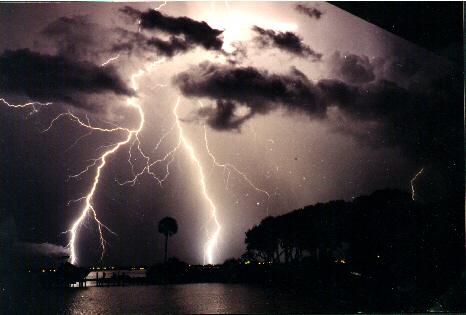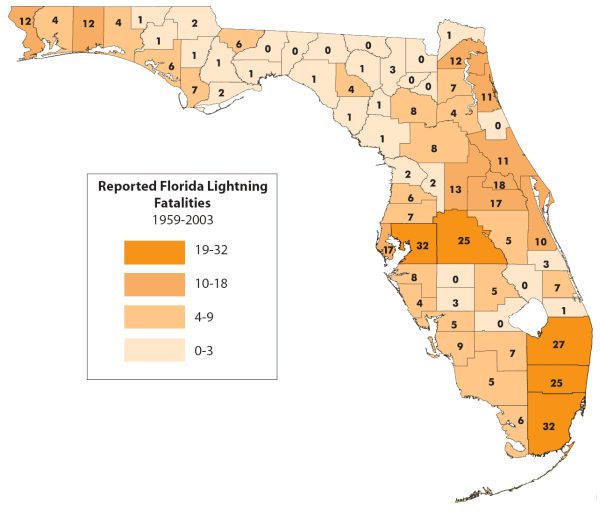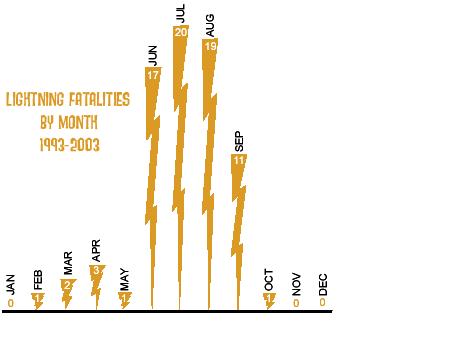|
Lightning Safety Rules
|
| Appoint someone to watch the skies during your outdoor work or recreation. Check the latest thunderstorm forecast and monitor the NOAA Weather Radio. When thunder roars, go indoors -- and stay there for 30 minutes after the last clap of thunder. |
| When lightning is in your vicinity, go quickly inside a completely closed building. Do not consider carports, open garages, covered patios, or pavilions as adequate shelter. |
| If no closed building is convenient, get inside a hard-topped all-metal vehicle. |
| Do not take shelter under a tree, especially if it is tall and isolated. |
| Get out of the water. This includes pools, lakes, rivers, oceans, water rides, and even puddled water. Get off the beach. |
| Put down metal objects such as fishing poles, golf clubs, tennis rackets, tools. etc. |
| Dismount from tractors and heavy construction equipment. Do not seek shelter under the equipment. |
| Move away from metal objects such as metal fences, metal sheds, telephone and power lines, pipelines, etc. |
| For Indoors |
| Avoid contact with corded phones. |
| Avoid contact with electrical equipment or cords. If you plan to unplug any electrical equipment, do so before the storm arrives. |
| Avoid contact with plumbing. When thunderstorms are occurring, do not take a shower or bath, wash dishes, or do the laundry. Wait until after the storm. |
| Move away from windows and doors. Do not stay on the porch. |
| Lightning Strike Victims |
| Have someone call 911 immediately; get professional help on the way. |
| Determine if the victim is unconscious. Call out their name or gently shake them. If there is no response, check to see if they are breathing. Gently roll the victim onto their back. |
| If the victim is not breathing, you will need to perform CPR until the paramedics arrive. Use the American Heart Association's "ABCs of CPR" to guide you through the process. |
| 1. Airway: clear obstructed airways. |
| 2. Breathing: perform mouth-to-mouth. |
| 3. Circulation: start chest compressions. |
| When Thunder Roars - Go Indoors! |
| When thunder roars, go indoors -- and stay there for 30 minutes after the last clap of thunder. |
| Myth & Truth |
Myth: Cars are safe because the rubber tires insulate them from the ground.
Truth: Rubber tires provide no protection from lightning. Cars are safe because of their metal shell and steel frame. Convertibles are not safe.
Myth: Lightning-strike victims are electrified and should not be touched.
Truth: Lightning-strike victims carry no residual electrical charge. It is perfectly safe to touch a lightning victim to give them first aid.
Myth: If it is not raining, then there is no danger from lightning.
Truth: Lightning often strikes outside of the rain area to as much as 10 miles (even greater distances in exceptional situations).
Myth: Heat lightning occurs after very hot summer days and poses no hazard.
Truth: Heat lightning is a term used to describe lightning from a thunderstorm too far away for the thunder to be heard. The lightning hazard increases as you move toward the storm and eventually the thunder will also be heard.
|
|
More About Lightning and Florida
|

Florida Lightning Capital of the U.S.
More people die from lightning strikes in Florida every year than in any other state. Why? It's simple really. We have more lightning, and we are fourth in population. On average, 10 people die each year from lightning. Statistics show that teenage boys are most vulnerable. People in their 30's are the next most likely victims, followed by those in their 20's.
Florida's unique location, surrounded by warm water, provides the necessary ingredients for thunderstorms to form. It has earned us the title of �Lightning Capital of the U.S.� Other places in the world have even more lightning though. According to a NASA study, there are areas in the tropics of Africa, Asia, and South and Central America that have more lightning then Florida does. Rwanda, a country in Africa, is known as the lightning capital of the world.

Click for a larger version of this image.
July The Cruelest Month
July is the worst month for lightning deaths in our state. Summer brings thunderstorms. In July, kids are not usually in school at all. They are more likely to be outside when a thunderstorm approaches. The Fourth-of-July holiday weekend is particularly dangerous. 
With many outdoor activities taking place during the afternoon and evening, a prime time for summer thunderstorms, it is easy to see why it can be so dangerous.
Some Lightning Facts
- The air in a lightning strike is heated to 50,000 degrees F. It is this rapid heating of the air that produces the shock wave that results in thunder.
- A ground stroke can produce somewhere between 100 million to a 1 billion volts of electricity.
- The average peak current in a cloud-to-ground lightning stroke is 100,000 amperes.
- The estimated diameter of a lightning channel is about 1 inch.
- The length of an average cloud-to-ground channel can range from 2 to 10 miles.
- You can tell how far away a lightning stroke is by counting the seconds between seeing the lightning flash and hearing the thunder. Five (5) seconds approximates one (1) mile of distance.
- If you see a flash and instantly hear the thunder, the lightning stroke was very close. Take shelter immediately.
- For more information, visit our Florida Lightning Information Center.
|